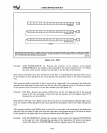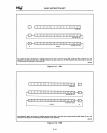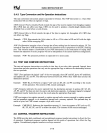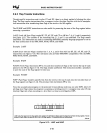
BASIC INSTRUCTION SET
Example:
INT
O.
Transfers control to the interrupt service routine specified
by
a type 0 interrupt,
which
is
reserved
for
a divide error.
INTO
(Interrupt on Overflow) invokes a type 4 interrupt if OF
is
set when the INTO instruction
executes. The type 4 interrupt
is
reserved for this purpose.
Example: INTO.
If
the result of a previous operation has set OF and
no
intervening operation has
reset
OF, then INTO invokes a type 4 interrupt. The interrupt service routine terminates
with an IRET instruction, which returns control to the instruction following INTO.
3.7
CHARACTER TRANSLATION
AND
STRING INSTRUCTIONS
The instructions in this category operate
on
characters
or
string elements rather than
on
logical or
numeric values.
3.7.1
Translate Instruction
XLAT
(Translate) replaces a byte in the AL register with a byte from a user-coded translation table.
When XLAT
is
executed, AL should have the unsigned index
to
the table addressed
by
BX.
XLAT
changes the contents of AL from table index
to
table entry.
BX
is
unchanged. The XLAT instruction
is
useful for translating from
one
coding system
to
another, such as from ASCII
to
EBCDIC. The
translate table may be up
to
256 bytes long. The value placed in the AL register serves as an index to
the location of the corresponding translation value.
Used with a LOOP instruction, the XLAT instruc-
tion can translate a block of codes up
to
64K bytes long.
Example: XLAT. Replaces the byte in AL with the byte from the translate table that
is
selected
by
the value
in
AL.
3.7.2
String Manipulation Instructions and Repeat Prefixes
The string instructions (also called primitives) operate
on
string elements
to
move,
compare, and scan
byte or
word
strings. One-byte repeat prefixes can cause the operation of a string primitive
to
be
repeated
to process stiings as long
as
64K bytes.
The repeated string primitives use the direction flag, DF, to specify left-to-right or right-to-left string
processing, and use a count in CX
to
limit the processing operation. These instructions use
the
register
pair
DS:SI
to
point
to
the source string element and the register pair ES:DI
to
point
to
the destination.
One of
two
possible opcodes represent each string primitive, depending
on
whether it
is
operating on
byte strings or word strings. The string primitives are generic and require one or more operands along
with the primitive ta
deter!!!.!ne
tht:'
si
7
t:'
of the string elements being processed. These operands
do
not
determine the addresses of the strings; the addresses must already be present
in
the appropriate
registers.
Each repetition of a string operation using the Repeat prefixes includes the following steps:
1.
'Acknowledge pending interrupts.
2.
Check CX for zero and stop repeating if CX
is
zero.
3.
Perform the string operation once.
3-22


















